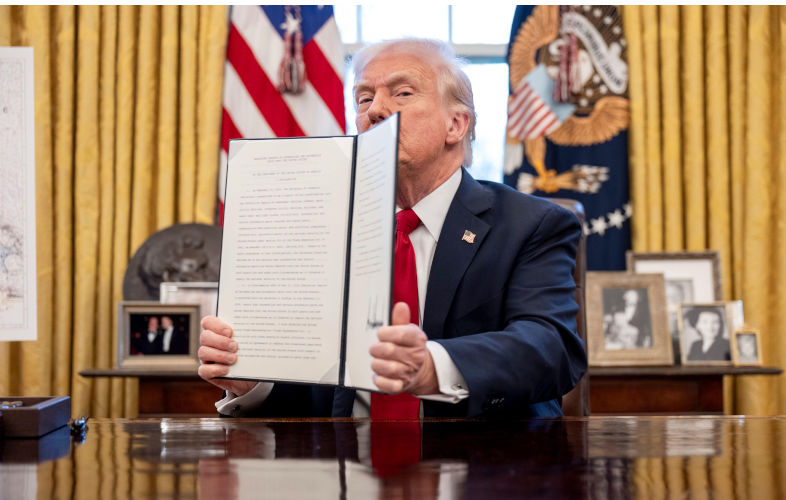Tariff deadline extended as Trump’s trade talks falter
July 10, 2025
It was supposed to be 90 trade deals in 90 days, turbocharged by the threat of ‘ Liberation Day’ tariffs.
Instead, as the original 9 July 2025 tariff pause deadline is extended to 1 August 2025, US President Donald Trump’s administration is limping to the finish line with one completed deal, one presumptive deal and a handful of others that are supposedly close to being finalised.
The various negotiations are still illuminating, offering insight into Trump’s priorities and tactics now that he has met almost all his key counterparts, with the major exception of Chinese President Xi Jinping.
Trump’s enthusiasm for striking deals is tempered by his lack of enthusiasm for compromise. Quick “wins” to calm financial markets and ensure business certainty are good — trade deficit reduction and reshoring of industrially salient industries is even better. When push comes to shove, the latter will not be substantially traded off for the former. Trump’s personal investment in deficit reduction and local production should not be underestimated, with his second term a last opportunity to leave an enduring mark. Japan, in particular, appears to have misjudged his relative disinterest in compromise.
The auto sector looms particularly large in Trump’s consciousness as a symbol of manufacturing, demanding maximum reshoring. The sector ran a US$160 billion trade deficit in 2024. The focus on localising production bodes poorly for South Korea, Japan and Germany, which exported 1.5 million, 1.4 million and 0.4 million vehicles respectively to the US in 2024. By contrast, the United Kingdom exported just over 100,000 units to the US. These 100,000 vehicles fall within quota and face a 10% tariff under the US-UK deal, while the out-of-quota auto tariff will remain at 27.5%.
It is unlikely the tariff-rate quota will be substantially altered to satisfy Seoul, Tokyo and Berlin. Swallowing the auto tariffs would amount to Japan having to “purchase the same horse twice”, given that it had conceded CPTPP-equivalent agricultural market access terms to the US under threat of Section 232 auto tariffs during Trump’s first term.
With 75% of the US goods trade deficit in 2024 composed of motor vehicle and auto parts, pharmaceutical products, machinery and electrical equipment, expect pharmaceutical tariffs to be next. The US pharmaceutical trade deficit in 2024 was US$139 billion. The steel sector is not far behind – tariffs introduced during Trump’s first term to ensure an 80% domestic capacity utilisation rate were already judged to be unlawful, but have since been doubled and broadened.
Non-tariff and behind-the-border barriers, such as digital services taxes, digital competition laws, food safety standards and conformity assessments, are not a current priority for Trump. These barriers were sidelined in the UK agreement, with a similar placeholder deal planned with the European Union.
The Trump administration has no love lost for the European Union’s supposedly “extorti[ve] and unfair [digital sector] fines and penalties” or the OECD’s supposedly unfair extraterritorial tax harmonisation rules. Modernising the global taxation system for the 21st century does not interest Trump, especially at the expense of US tech companies. The administration has armed itself with an obscure 1930s-era provision from the tax code to strike back when these penalties come due. But this is a weapon to be wielded another day. Today, it is all about goods trade deficits and tariffs.
Meanwhile, China was not at the table but on the table at the June 2025 G7 Summit in Canada. The UK deal requires London to align its supply chain security standards with ongoing and future Section 232 investigations, including scrutiny of Chinese-owned steel and aluminium production facilities in the United Kingdom.
With investigations expanding to copper, timber and lumber, semiconductors, pharmaceuticals, trucks, processed critical minerals and commercial aircraft and jet engines, the United Kingdom’s — and other countries’ — trade ties with China will inevitably be affected going forward.
US officials have also hinted that tariffs on partners and allies could be reduced in exchange for isolating China from its markets. Whether these officials are capable, or interested, in distinguishing genuine Vietnamese value addition from Vietnam-transhipped goods, remains to be seen. Japan and the European Union have offered co-operation in the semiconductor, critical minerals, aviation and shipbuilding sectors – building on co-operative endeavours initiated during the Biden administration.
China and its market remain the biggest prize to be won, ideally through a resurrected Phase One-type agreement. That deal had envisaged a two-year US$200 billion increase in US exports over a 2017 baseline. No other country or region can absorb the sheer scale of goods that the mercantilist US president wishes to hawk. Besides, the experience of his first term taught Trump that China is amenable to such market-based targets, while other trading partners prefer to offer bilateral liberalisation — which could add to US deficits — rather than commit to significant purchases.
The operative question for Trump is this — if he insists on broadening the decoupling of US investment and technology ties with China, what is the reciprocal Chinese interest in opening its market to additional managed purchases of US goods and services? The export control cloud that hovers above their trade negotiation could dampen the chances of success.
The “Liberation Day” tariff announcement was greeted by the single largest weekly rise in 30-year US Treasury bond yields since 1987. The negotiation outcomes so far have been almost as dismal. The administration’s overall approach bodes extremely poorly for the United States’ engagement with the rules-bound trading order that it had established 75 years ago.
Republished from East Asia Forum, 8 July 2025
The views expressed in this article may or may not reflect those of Pearls and Irritations.

